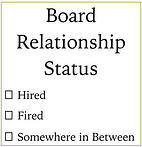 Last week I met with an experienced chief administrator who was recently unceremoniously fired by a school board. After being recruited from another school a few years earlier, this person had the misfortune of working with three different board chairs in about 18 months. The relationship with the third chair soured quickly, and the rest of the board followed. The result was a predictable pattern.
Last week I met with an experienced chief administrator who was recently unceremoniously fired by a school board. After being recruited from another school a few years earlier, this person had the misfortune of working with three different board chairs in about 18 months. The relationship with the third chair soured quickly, and the rest of the board followed. The result was a predictable pattern.
Dissension among the school community.
Disintegration of faculty culture.
Disruptive board behavior.
Damaged egos and emotional scars.
None of this contributed well to the students.
What caused this situation among such intelligent and well-meaning people? What steps could your board take to minimize the risk of repeating this history?
THE most important relationship for a school or district is that between the chief administrator and the school board chair. When this relationship fails, the entire school fails.
Frequent changes in the board chair are sometimes mandated in the bylaws. One board chair I once met with was proud that he had revised their bylaws to require a new board chair every year. Such frequent change in leadership causes extremely high stress on the chief administrator, because of the adaptations and adjustments required for each new chair. High turnover in the chair position usually equates to high turnover for the chief, and that's a prescription for mediocrity and bureaucracy in your school, district, or diocese. The polarity between term limits and leadership consistency has various solutions, but our recommendations favor the latter.
What causes strife in the valuable connection between the chair and the chief?
1. Conflicting expectations, where the vision and priorities of the two are incompatible.
2. Misalignment in values, personality, and methods of authority.
3. Inability to genuinely collaborate and innovate.
4. Lack of clarity and agreement on the boundaries between governance and management.
5. Deficiencies in emotional maturity that limit the capacity to respond to strife and crises.
6. A board culture that is tolerant of apathy and/or aggression among its members and toward the chief.
Take the time this year to intentionally create a healthy, productive relationship between the board chair and the chief administrator. Allow and encourage them to have an appropriate level of confidentiality and connection that supports long-term growth.


